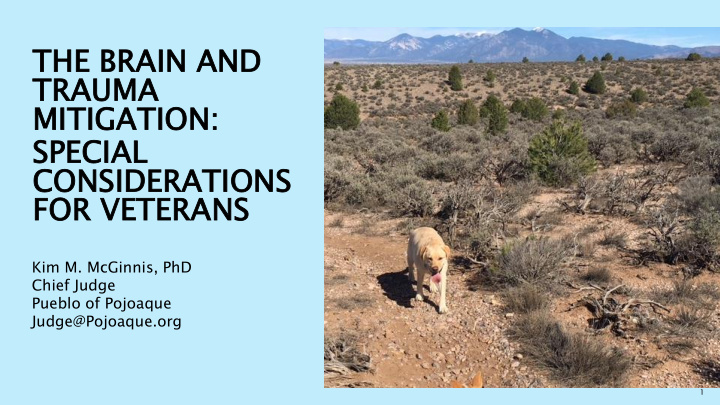



THE BR E BRAIN IN AND ND TRAUMA A MITIGAT IGATION ION: : SP SPEC ECIAL CO CONS NSIDER DERATIONS IONS FOR VET ETER ERANS NS Kim M. McGinnis, PhD Chief Judge Pueblo of Pojoaque Judge@Pojoaque.org 1
Understand, derstand, recogni gnize, ze, and d respon spond d to trauma Focus us on phys ysic ical, al, psycho ycholo logic gical, al, and d emotional onal safety fety He Help parti rticipants ipants rebu build ld a sense of control and empowerment 2
An experience that overwhelms a person’s ability to cope/stay present Act first. Think later. 3
Military Personnel: Co-Occurring Disorders 4
Traumatic Brain Injury An alteration in brain function, or other evidence of brain trauma, caused by an external force (Menon et al., 2010, p. 1638; Common Data Elements for research on TBI and Psychological Health) 5
Ove verlap: lap: TBI I and nd PTSD TSD PPCS: Persistent Post-Concussion Symptoms (TBI) Stein & McAllister 2009 6
7
Trauma/Stress Response A natural response to an unnatural circumstance Brain survival mode/self preservation Hypervigilance May cause people to act in unexpected ways 8
• Thalamus amus: receives sensory input and relays to amygdala and cortex • Amygda dala la: smoke alarm; emotional information about situations/conditioned responses • Hippocamp mpus us: storage/ retrieval of emotion laden memories with input from amygdala • Pre-fr frontal ntal cortex/cer cerebru rum: forethought/planning; impulse control. Goal directed behavior. 9
Pre-Frontal Cortex= Brakes 10
Amygdala Hijack 11
Threat/Trauma Trigger Fight Flight Freeze Surrender 12
What if the mountain lion lives with you? 13
Toxic/Chronic Stress/Trauma Remodels the Brain Center on the Developing Child at Harvard University 14
Substance misuse changes the Brain 15
16
Hippocampus Amygdala Pre-frontal cortex 17
Glucose cose Metabo boli lism sm (coca caine ine) D2 Re Rece ceptors tors (meth) th) Atrophy phy Source: NIDA 18
Epigenetics/Historical Trauma Historical Trauma is “a constellation of characteristics associated with massive cumulative group trauma across generations” -Dr. Maria Yellow Horse Braveheart (1999) 19
Relapse Conditioned response (context-related) Stress/Trauma Re-exposure to substance 50% of people who get treatment for any addiction remain sober after first year 20
Rat Park/Decrease Social Isolation 22
Healing Happens through Connection and Relationship Resilience comes from safe, stable, nurturing, supportive relationships and environments 23
Pro-Social Activities Traditional crafts, cultural connections Outdoor activities: hiking, fishing, nature walks Group outings: movies, bowling Community meals Peer Support Groups 24
Promote SAFETY Create an environment conducive to limiting arousal Environment should be comfortable: temperature, light, and noise 26
Rules Reduction in Wellness Court No food or drink No gum No hats No sunglasses No shorts No swearing Is the rule about safety or support? Or is the rule used to exert power and control over the participant? 27
Working Toward a Trauma Informed/Healing Focused Wellness Court Trauma Assessment Trauma Certification for Staff Motivational Interviewing training for all staff, including the judge Seeking Safety or other trauma- focused groups Reflective Supervision 28
Trauma Informed Communication Maintain a calm/patient demeanor (open face) Speak slowly and clearly Allow plenty of time for the participant to respond Know that slow responses do not equal lower intelligence 29
JUDGE’S COMMENT PERCEPTION EPTION OF TRAUM UMA TRAUMA UMA-INF INFORM ORMED ED SURVI VIVO VOR APPRO ROACH “Your drug screen is dirty.” “I’m dirty. There is “Your drug screen shows the something wrong with me.” presence of drugs.” “Did you take your pills “I’m a failure. I’m a bad “Are the medications your today?” person. No one cares how doctor prescribed working the drugs make me feel.” well for you?” “You didn’t follow the “I’m hopeless. Why should I “Maybe what we’ve been contract, you’re going to jail; care how I behave in jail? doing isn’t the best way for we’re done with you. There is They expect trouble anyway.” us to support you. I’m going nothing more we can do. to ask you not to give up on recovery. We’re not going to give up on you.” “I’m sending you for a “I must be crazy. There is “I’d like to refer you to a mental health evaluation.” something wrong with me doctor who can help us that can’t be fixed.” better understand how to support you.” SAMHSA 30
Create a shared definition of trauma Prioritize secondary trauma Solicit support of community members 31
Ne Neuro roplas lastici ticity ty 32
Thank you!
Recommend
More recommend